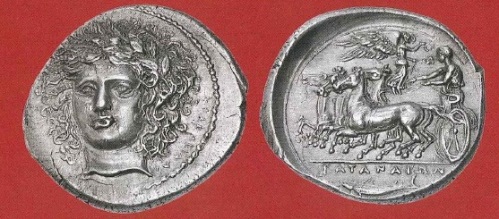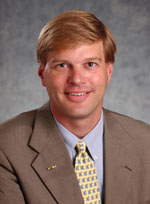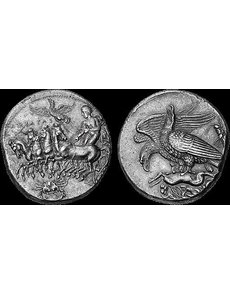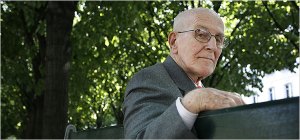UPDATE 8/5/14: The federal government has returned to Greece five ancient coins that were seized from Dr. Weiss after his arrest in Jan 2012. They are among 23 coins Weiss was forced to forfeit during the investigations detailed below, according to ICE.
Caveat Emptor, the court-mandated essay written by Rhode Island coin dealer Arnold Peter Weiss, is a long-overdue call for collectors of ancient coins to begin following the law.
Weiss is the prominent Rhode Island hand surgeon and ancient coin dealer who was arrested on January 3rd at the Waldorf-Astoria Hotel in New York City for felony possession of an ancient coin recently looted from Sicily. He has served as a board member of the American Numismatic Society, the founder of a Swiss coin dealership and a prominent donor to American universities. According to the criminal complaint, he was caught on tape telling a police informant that he knew the coins had been recently looted in Sicily: “There’s no paperwork, I know this is a fresh coin, this was dug up a few years ago.” In July, Weiss pleaded guilty to three counts of attempted criminal possession of ancient coins. It turned out the “looted” coins were clever forgeries.
 As part of Weiss’ plea bargain, he agreed to write an essay that “will raise needed awareness about unprovenanced coins and will promote responsible collecting among numismatists.” That article has now been published in the American Numismatic Society Magazine. (See the complete article below.)
As part of Weiss’ plea bargain, he agreed to write an essay that “will raise needed awareness about unprovenanced coins and will promote responsible collecting among numismatists.” That article has now been published in the American Numismatic Society Magazine. (See the complete article below.)
The situation recalls a scolded student being forced to write a half-hearted apology on the chalkboard. But Weiss’ essay is worth reading for what it reveals about the trade in ancient coins.
Weiss opens with a candid admission: “I was very active in the ancient coin marketplace and paid little attention to foreign cultural property laws, as if they really did not matter within the U.S. Well, they do.” Weiss is not alone — coin collectors have often displayed a surprising ignorance of the laws that govern their hobby, or open disdain for them. Weiss’ arrest has become an object lesson for the field, and Weiss uses his essay to underscore the point:
“Until recently, the prevailing view among coin dealers and collectors in the US has been that such foreign laws do not affect the purchase of objects in the US….Whether one agrees or not with the various laws of Italy, Turkey or China, for example, this must take a secondary role in this debate. The US honors the laws of cultural patrimony of foreign nations where those laws are in place and enforced by the source country.”
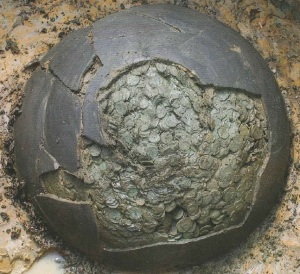 He is referring, of course, to the McClain Doctrine and the National Stolen Property Act, which makes it a crime to purchase or possess looted antiquities taken from a country with patrimony laws that are reasonably enforced. (See here and here for more on the law.)
He is referring, of course, to the McClain Doctrine and the National Stolen Property Act, which makes it a crime to purchase or possess looted antiquities taken from a country with patrimony laws that are reasonably enforced. (See here and here for more on the law.)
Weiss goes on to expose the coin market’s dirty secret: the hoards of ancient coins that regularly appear on the market today are almost certainly the product of looting.
“Dealers and collectors with any reasonable experience can tell that such a simultaneous offering just does not happen naturally, except after a recent hoard of coins has been found and dispersed into the marketplace….The purchase of coins that derive from hoards is likely to be illegal and detrimental to scholarship, and these might be reasons enough for the buyer to be aware.”
 This admission — both obvious and long-denied by collectors — is reminiscent of another remarkable whistle-blower moment: Getty Museum antiquities curator Marion True’s June 2000 speech before the Assoc. of Art Museum Directors, in which she told museum officials that it was time to accept the fact that most, if not all, undocumented antiquities were the product of looting.
This admission — both obvious and long-denied by collectors — is reminiscent of another remarkable whistle-blower moment: Getty Museum antiquities curator Marion True’s June 2000 speech before the Assoc. of Art Museum Directors, in which she told museum officials that it was time to accept the fact that most, if not all, undocumented antiquities were the product of looting.
But Weiss notes another reason for careful collecting: The prevalence of sophisticated forgeries on the market, like the ones he was trying to sell in New York City. Weiss notes such forgeries share something in common with looted coins: the lack of a clear collecting history.
They come with fantastic stories…From personal experience I can say that these forgeries are stunning and are being introduced into the coin market with fake provenance information…Forgery is often the domain of highly-organized criminal enterprises, most often based in the source countries themselves, but now occurring worldwide due to the spread of high-tech machinery.
Weiss concludes his essay with a call for “a different kind of collecting requiring a proactive rather than passive approach to provenance” and outlines six steps every collector of ancient coins should take:
1. Research the history. No excuse not to — the ANS has a complete set of auction catalogs dating back to the 18th Century.
2. Ask questions. Weiss notes coyly that “sometimes dealers or curators know more about the coins than might be published.”
3. Beware the Old Swiss Collection and other bogus provenance. As Weiss notes, “the words ‘collection of’ for a coin that has never been previously published or documented ought to be a sign that further research is required.”
4. Know the Law. Weiss notes the “complex” and “contradictory rules” on what is legal to acquire, but offers 1970 as an accepted cut-off date for when an object should have left its country of origin.
5. Trust your Gut. If a coin feels “wrong,” don’t buy it.
6. Avoid recent hoards. Look out for coins with gleaming smooth surfaces, come in multiples and offered by the dozen.
This is a decent checklist for all antiquities collectors to obey. But what is perhaps most remarkable is that in 2012 this needs to be explained to coin collectors. One is left to wonder whether the problem with the market today is really ignorance of the laws or merely a stubborn unwillingness to obey them.
 Will Weiss’ essay — published by the official organ of the US coin collecting community — mark a turning point? It should. Ute Wartenberg Kagan, the executive director of the American Numismatic Society, took the opportunity to announce the ANS’s new collecting policy, which is more strict that the steps outlined by Weiss.
Will Weiss’ essay — published by the official organ of the US coin collecting community — mark a turning point? It should. Ute Wartenberg Kagan, the executive director of the American Numismatic Society, took the opportunity to announce the ANS’s new collecting policy, which is more strict that the steps outlined by Weiss.
In a strongly worded editorial, she too calls for a new era of collecting — “a path of responsibility, careful research, and best practices to enhance numismatics and the responsible collecting and caring for of ancient coinage and history.”
“Collecting ancient coins will be different,” she assures her members, “but will not die out.”
Ultimately, the success of Weiss’ statement and the ANS’s new policy at changing the culture of American coin collectors will be measured by the time. If criminal cases continue to reveal collectors buying unprovenanced coins like those Weiss warned against, we’ll know that ignorance was never the problem with the market in ancient coins.
UPDATES:
Archaeologist Paul Barford has written about Weiss’ essay here, noting several things Weiss has omitted: details on his own case; the role of dealers like himself; the importance of precise find spots, not just hoards; the role of ethics that go above and beyond the letter of the law.
Coin collector lobbyist Peter Tompa has (finally) written about the Weiss case. He says he “doesn’t have much to quibble with” about Weiss’ advice, but notes that the statement was made under duress and questions whether the “archaeological lobby” might have edited it.
Ute Wartenberg has responded to Tompa on his blog, saying, “ANS staff and I edited the piece after it was submitted, but the people acknowledged in my editorial preface such as John Russell, who is a professor of Near Eastern Archaeology, kindly provided illustrations at my request. Their names can be found with the relevant photos. None of those acknowledged read Weiss’ article or provided editorial comment.” So much for that theory.
Ever the provocateur, Arthur Houghton (who describes himself as a friend of Peter Weiss) picks up Tompa’s theory in the same thread and runs with it: “Who else may have intervened in the article’s wording and who may have cleared it for publication…And did those or any other person in authority then coerce, by subtle suggestion or by direct demand, the Society to publish? Could we have a little transparency please?” Houghton goes on to tell Col. Bogdanos to “man up” and “come out of the shadows.” “…Let us know exactly what your role was in creating, framing and clearing Peter Weiss’ article? But could we have a little confession from you at an early moment?”
Tompa has the last word, saying he has confirmed with Wartenberg that “the articl [sic] had to be approved by Col. Bogdanos as part of the plea deal, but any changes to the article based on comments from the NY District Attorney’s office or any sources the DA consulted, took place BEFORE the ANS accepted the article for publication and it was edited by ANS staff.”
Our final thought: No one would dispute that Weiss’ essay was “coerced” — it was a condition of the plea deal after he was caught breaking the rules he claims to promote. We are far more interested in Tompa’s and Houghton’s thoughts on the worthiness of those rules and the new ANS policy. Helpfully, Tompa has offered this link. For those wondering about Houghton’s views (and actions) on the law, we offer this.
A few additional questions we’d welcome thoughts on: Are ancient coin collectors often ignorant of the law, as Wartenberg suggests? Or have they flouted it knowingly, perhaps because they think it’s unfair? Have the ANS and other leaders in this area done enough to educate their members about the law and enforce a code of ethics in the field? And if Weiss hadn’t written as a condition of a plea deal but instead was whispering to a trusted friend, what would he have said?

